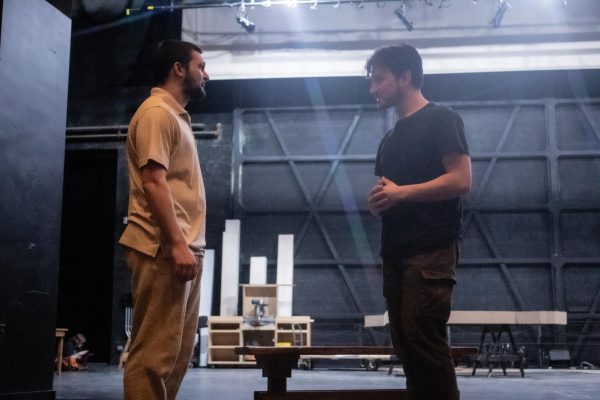Rare tie means two winners selected for Concerto Competition
In an unusual turn of events, this year’s Concerto Competition resulted in a tie.
Two seniors, percussionist Michael Ciniglia and flautist Andrew Jonah Vicente, were selected as the winners of the Conservatory’s annual Concerto Competition, which was held in Kulas Musical Arts Building’s Gamble Auditorium on Sunday, Oct. 29. They were chosen from a pool of six finalists. The other four competitors were senior vocalist Sabina Balsamo, senior pianist Greta Pasztor, senior violinist Kavita Shankar, and junior violinist Chloe Wehner.
The winners of the Concerto Competition will have the opportunity to perform their solo with the BW Symphony Orchestra. Ciniglia’s performance will be on the Dec. 1 BWSO concert, and Vicente’s will be on April 27.
Ciniglia, a percussion performance and music education double major, performed Michael Burritt’s “Concerto for Marimba” with the accompaniment of pianist Denella Sing and percussionist Alex Morrow.
A contemporary composition, the 28-minute concerto is comprised of contrasting movements, said Ciniglia. The first is a “surreal” movement that “paints a picture” for the listener; it is followed by a “reverent” second movement and a third movement that is “very intense but…also very beautiful.”
This was Ciniglia’s first time participating in the Concerto Competition. He had learned the first movement in Spring 2017, and he learned the second two movements this fall. As the concerto competition requires participants to perform a large, difficult work entirely from memory, many students choose to learn their concerto over the summer. Ciniglia, however, does not own a marimba and didn’t have access to one in the summer months, so he had to learn his concerto during the semester.
“I spent so much time in the practice room just this semester, honestly,” said Ciniglia. “I was spending like five, six hours a day on [the concerto] for seven, eight weeks of the school year, learning it, practicing it. I rehearsed with my accompanist at least three times a week.”
Vicente, who is seeking dual degrees in flute performance and math, performed the flute transcription of Armenian composer Aram Khachaturian’s “Concerto for Violin and Orchestra” with the accompaniment of pianist Rei Sakuri. Composed for violin in 1940 and transcribed for flute in 1968, to 40-minute work has a “lush, folk vibe” and an “exotic flair,” juxtaposing “powerful orchestral moments” with “lyrical…beautiful melodies,” said Vicente.
Last month’s Concerto Competition was Vicente’s third at BW. Last year, he was one of three students to advance to the final round. As he has done in the past, Vicente chose to prepare and memorize his concerto in the summer.
“In the summer, I basically decided that since it was such a long piece, I had to really set goals for when I was going to have different parts [learned],” said Vicente. “I basically did a movement per month.”
Both Ciniglia and Vicente had to pass the preliminary round of the competition on Oct. 15 before proceeding to the final round. The preliminary rounds were judged by Conservatory faculty members.
For the final round, three guest judges, all professional musicians affiliated with other orchestras and universities, provided written feedback for each competitor and assigned them an overall rating from 1 to 5, 5 being the best.
Susan Van Vorst, dean of the Conservatory, is the official tiebreaker for the competition. After consulting with Dr. Chang, the interim director of orchestral studies, to see if it would be possible to accommodate two winners, she decided not to break the tie.
“My role in all of that is to be the conduit, really—just the messenger between what our judges are saying and what the conductor may or may not be able to do,” said Van Vorst.
Van Vorst said that she was glad that the BW community would have the opportunity to experience the performances of these two hardworking students.
“They were all extraordinary and I wish we could’ve presented every one of them,” said Van Vorst.
“The repertoire is very diverse, the instrumentation is very diverse…it really would be an extraordinary thing not only for the orchestra but for our audience and other students and the community in general.”
The Exponent is looking for financial contributions to support our staff and our newsroom in producing high-quality, well-reported and accurate journalism. Thank you for taking the time to consider supporting our student journalists.












































